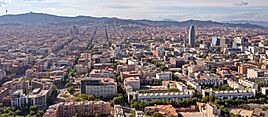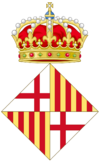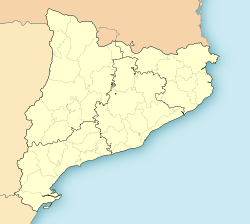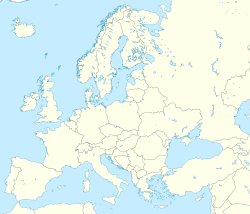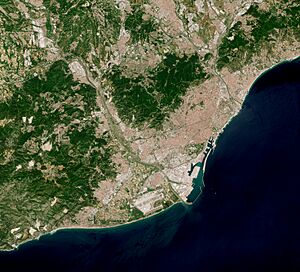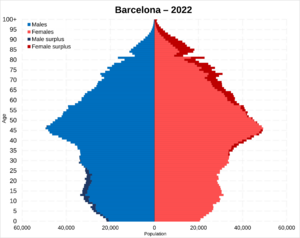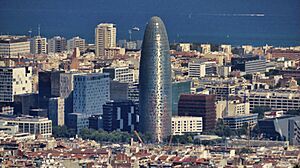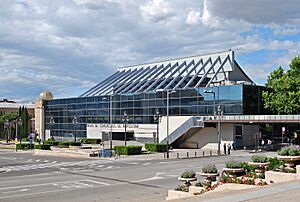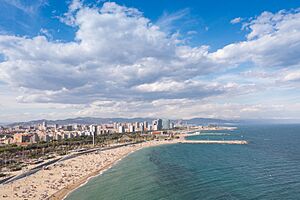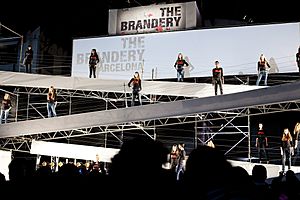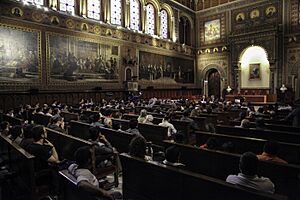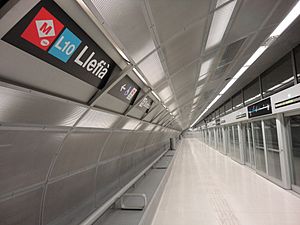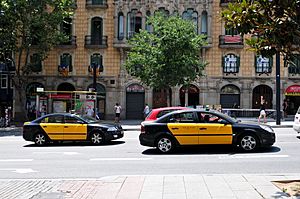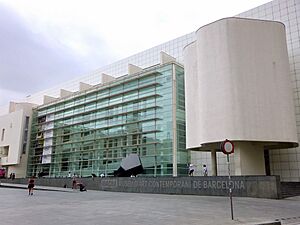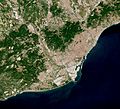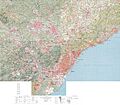Barcelona facts for kids
Quick facts for kids
Barcelona
|
|||
|---|---|---|---|
|
City and municipality
|
|||
|
|
|||
|
|||
| Nicknames: | |||
| Country | Spain | ||
| Autonomous community | Catalonia | ||
| Province | Barcelona | ||
| Comarca | Barcelonès | ||
| Districts |
10 districts
Ciutat Vella
Eixample Gràcia Horta-Guinardó Les Corts Nou Barris Sant Andreu Sants–Montjuïc Sarrià-Sant Gervasi Sant Martí |
||
| Government | |||
| • Type | Ajuntament | ||
| • Body | City Council of Barcelona | ||
| Area | |||
| • City | 101.4 km2 (39.2 sq mi) | ||
| Elevation
(AMSL)
|
12 m (39 ft) | ||
| Population
(2018)
|
|||
| • City | 1,620,343 | ||
| • Rank | 2nd | ||
| • Density | 15,980/km2 (41,387/sq mi) | ||
| • Urban | 4,840,000 | ||
| • Metro | 5,474,482 | ||
| Demonyms | Barcelonan, Barcelonian barceloní, -ina (Catalan) barcelonés, -esa (Spanish) |
||
| GDP | |||
| • Metro | €159.8 billion (2020) | ||
| Postal code |
080xx
|
||
| Area code | +34 (E) 93 (B) | ||
| INE code | 08 0193 | ||
| City budget (2023) | €3.6 billion | ||
| Official language | Catalan and Spanish | ||
| Main festivity | La Mercè | ||
| Patron saint | Eulalia of Barcelona | ||
Barcelona (![]() i/ˌbɑːrsəˈloʊnə/ BAR-sə-LOH-nə; Catalan: [bəɾsəˈlonə]; Spanish: [baɾθeˈlona]) is a vibrant city on the northeastern coast of Spain. It is the capital and largest city of Catalonia, a special region in Spain. Barcelona is also the second-biggest city in Spain by population.
i/ˌbɑːrsəˈloʊnə/ BAR-sə-LOH-nə; Catalan: [bəɾsəˈlonə]; Spanish: [baɾθeˈlona]) is a vibrant city on the northeastern coast of Spain. It is the capital and largest city of Catalonia, a special region in Spain. Barcelona is also the second-biggest city in Spain by population.
Around 1.6 million people live within the city limits. If you include the nearby towns, the greater Barcelona area is home to about 5.3 million people. This makes it one of the largest cities on the Mediterranean Sea. It sits between two rivers, the Llobregat and the Besòs, with the Serra de Collserola mountains to its west.
People believe Barcelona was founded a very long time ago by traders from Phoenicia or Carthage. In the Middle Ages, it became the capital of the County of Barcelona. Later, it joined with the Kingdom of Aragon, becoming a very important city. Barcelona has a long history of wanting to be independent, even becoming part of France for a short time under Napoleon. It was also a key city during the Spanish Civil War. After Spain became a democracy in the 1970s, Barcelona once again became the capital of an independent Catalonia.
Today, Barcelona is famous for its rich culture and is a popular place for tourists. Many buildings designed by architects like Antoni Gaudí are so special that they are World Heritage Sites. The city also has top universities and hosted the 1992 Summer Olympics. It's a major center for business, culture, and travel in Europe.
Contents
Barcelona's Name and Meaning
The name Barcelona comes from an old Iberian word, Baŕkeno. You can even see this name on ancient coins! Some people think the city might have been named after a Carthaginian general, Hamilcar Barca, but there's no clear proof.
Over time, the name changed to things like Barchinona and Barçalona. Locals sometimes call the city Barna. But be careful! Barça is only used for the famous football club, FC Barcelona, not the city itself. Another common short name is 'BCN', which is also the code for the Barcelona-El Prat Airport.
The city is also known as the Ciutat Comtal in Catalan or Ciudad Condal in Spanish. Both mean "City of Counts." This name comes from its past as the home of the Counts of Barcelona.
A Look at Barcelona's Past
The very first settlements in Barcelona are a bit of a mystery. We know people lived here over 7,000 years ago! Some old Greek stories even say the hero Hercules founded the city.
Early Settlements
Tradition says that Phoenician traders first settled here. Later, the Carthaginian general Hamilcar Barca might have founded a city called Barcino in the 3rd century BC. However, coins from that time show the name Bárkeno, which means "The Place of the Plains" in an ancient language. This suggests the local people, called the Laietani, used this name.
Roman Times in Barcelona
Around 15 BC, the Romans built a military camp, or castrum, on a small hill called "Mons Taber." This spot is still the political heart of the city today!
Under the Romans, Barcelona was a colony called Barcino. It wasn't as big as nearby Tarraco (modern Tarragona), but it grew because it had a great location and a good harbor. The city even made its own coins.
You can still see parts of Roman Barcelona today. The Barcelona City History Museum (MUHBA) has amazing Roman ruins underground. The old city center, the Barri Gòtic (Gothic Quarter), still follows the Roman street plan. Parts of the old Roman walls are even built into the Barcelona Cathedral.
Medieval Barcelona
In the early 5th century, the Visigoths took over Barcelona and made it their capital for a few years. Later, in 801, Charlemagne's son Louis conquered the city. He made Barcelona the center of the "Hispanic March," a buffer zone ruled by the Counts of Barcelona.
The Counts of Barcelona became more and more independent. In 1137, the County of Barcelona joined with the Kingdom of Aragon. This created the Crown of Aragon, which became a powerful force in the western Mediterranean Sea. Barcelona was its most important city.
In 1401, Barcelona started one of Europe's oldest public banks, the Bank or Taula de canvi de Barcelona.
Barcelona Under Spanish Rule
In 1469, the marriage of Ferdinand II of Aragon and Isabella I of Castile united the two main kingdoms of Spain. Madrid became the new center of power. Barcelona's importance in Mediterranean trade lessened as Spain focused on exploring the Americas.
Barcelona was a center for people who wanted Catalonia to be separate from Spain. There were even revolts, like the Reapers' War (1640–52). A terrible plague in the 1650s cut the city's population in half.
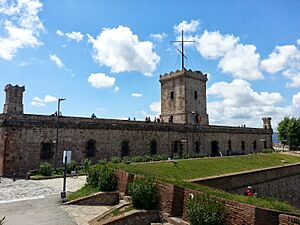
In the 18th century, a fortress was built on Montjuïc hill, overlooking the harbor. This fortress was even used by French scientists to help measure the first official meter! The Napoleonic wars affected Barcelona, but then the city began to industrialize, and things improved.
Modernizing the City
In the mid-1850s, Barcelona was very crowded. A civil engineer named Ildefons Cerdà came up with a brilliant plan for a new district called the Eixample. He wanted wide streets, gardens, and good services for everyone.
His plan created the famous octagonal blocks with cut-off corners that you still see today. These corners help traffic flow better. Cerdà's ideas helped Barcelona become known worldwide for its smart city planning.
Recent History and Changes

During the Spanish Civil War, Barcelona supported the Republican government. After the war, when Francisco Franco took power, Catalonia's special government was removed, and the Catalan language was not allowed in public. Despite this, Barcelona remained a major industrial city. Many people from poorer parts of Spain moved to Barcelona, causing the city to grow quickly.
After Franco's death in 1975, Spain became a democracy again. Barcelona pushed for Catalonia to regain its self-rule, which happened quickly.

A big change for Barcelona came in 1992 when it hosted the 1992 Summer Olympics. This event led to huge improvements, like new beaches and roads. The city became much more popular for tourists.
In recent years, Barcelona has been a key city for the Catalan independence movement. In 2023, Barcelona was named the UNESCO-UIA World Capital of Architecture for 2024–2026. This honor shows how important architecture is to the city's history and future.
Barcelona's Geography
Barcelona is on the northeast coast of Spain, right on the Mediterranean Sea. It sits on a flat area about 5 kilometers (3 miles) wide. This plain is surrounded by the Serra de Collserola mountain range, the Llobregat river, and the Besòs river. The city is about 120 kilometers (75 miles) south of the Pyrenees mountains and the border with France.
Tibidabo mountain, 512 meters (1,680 feet) high, offers amazing views of the city. On top of it is the Torre de Collserola, a tall telecommunications tower. Barcelona also has smaller hills, many of which have neighborhoods built on them, like Carmel and Putget.
The Montjuïc hill, 173 meters (568 feet) high, overlooks the harbor. On top of Montjuïc is a castle, and the hill is home to many sports venues, cultural spots, and Barcelona's largest park.
Barcelona's Weather
Barcelona has a Mediterranean climate. This means it has mild winters and warm to hot summers. The rainiest times are in autumn and spring.
The average temperature in Barcelona is about 21.2°C (70.2°F) during the day and 15.1°C (59.2°F) at night. In January, the coldest month, temperatures are usually between 12°C and 18°C (54-64°F) during the day. In August, the warmest month, temperatures are typically between 27°C and 31°C (81-88°F) during the day.
It rarely snows in Barcelona city, but you might see light snow in the nearby Collserola mountains. The city gets about 2,524 hours of sunshine each year.
People of Barcelona
Barcelona is a very crowded city, one of the most densely populated in Europe. In 2016, about 1.6 million people lived in the city. The wider Barcelona area, including nearby towns, has over 3.2 million people.
The city's population grew a lot from the 1950s to the 1970s, as many people moved from other parts of Spain. After a dip, the population started growing again after 2000, partly due to new people moving in from other countries.
Languages Spoken
Spanish is the most spoken language in Barcelona, and almost everyone understands it. Catalan is also very common. About 95% of people understand Catalan, and 72% can speak it. Learning Catalan has become much more popular in recent years.
Besides Spanish and Catalan, many other languages are spoken in Barcelona due to its diverse population. These include Arabic, Bengali, Urdu, Mandarin Chinese, and Romanian.
Who Lives in Barcelona?
In 2016, about 59% of Barcelona residents were born in Catalonia, and 18.5% came from other parts of Spain. About 22.5% of the population was born outside of Spain. This number has grown a lot since 1996.
Many people come from other European countries like Italy and France. There are also many people from Latin American countries such as Bolivia, Ecuador, and Colombia. Barcelona also has a large Pakistani community and other groups from Asia, like China and the Philippines.
Religion in Barcelona
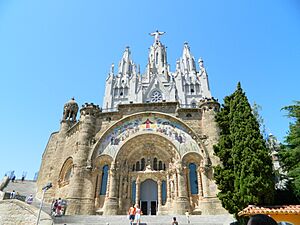
Most people in Barcelona identify as Roman Catholic. However, the number of people who say they are Catholic has been decreasing.
Barcelona province has a large Muslim community, many of whom are from Morocco. The city also has the largest Jewish community in Spain. Other religious groups include Evangelical Christians, Jehovah's Witnesses, Buddhists, and Eastern Orthodox Christians.
Barcelona's Economy
Barcelona is a very important economic center in southwestern Europe. It's known for being a major hub for new technologies, especially in biotech. The city is considered a "global city" because of its influence around the world.
Barcelona is also a major transport hub. Its port is one of Europe's busiest for passengers and cargo. Barcelona–El Prat Airport handles over 50 million passengers each year. The city has a large network of highways and a high-speed rail line connecting it to France and other parts of Europe.
Barcelona has a long history of trade and industry. It was one of the first industrial cities in the Mediterranean region, especially known for its textile factories. Today, the services sector is the biggest part of its economy, but manufacturing is still important.
Trade Shows and Tourism
Barcelona has large convention centers, like Fira de Barcelona, which is one of the biggest in Europe. It hosts many national and international events each year. The World Trade Center Barcelona is also an important business hub located in the city's port.
The city is famous for hosting big events, like the 1888 and 1929 World Expositions, and the 2004 Universal Forum of Cultures.
Barcelona is a top tourist spot, ranking among the most visited cities in the world. It has many fun places, beautiful beaches, a pleasant climate, and famous historical sites, including eight UNESCO World Heritage Sites. The city has many hotels, including luxury ones.
While tourism brings a lot of money to Barcelona, it also brings challenges. The city has seen protests from residents who feel that too many tourists are making housing more expensive and public places too crowded. The city government is trying to manage tourism better, for example, by limiting new hotels.
Industries in Barcelona
Industry makes up about 21% of the region's economy. Key industries include energy, chemicals, and metals. Barcelona has also been an important center for making cars for a long time. Today, the headquarters and a large factory for SEAT, a major Spanish car maker, are in a Barcelona suburb. Nissan also has a factory here.
The main industries now are textiles, chemicals, pharmaceuticals, cars, electronics, printing, and information technology. Barcelona is also known for hosting the Mobile World Congress, a big event for the telecommunications industry.
Fashion in Barcelona
Barcelona has a strong history in textiles, and it's trying to become a major fashion center. In 2015, Barcelona was named the seventh most important fashion capital in the world.
Education in Barcelona
Barcelona has excellent universities. The most famous are the University of Barcelona (founded in 1450) and the Pompeu Fabra University. There's also the Polytechnic University of Catalonia for engineering and technology. Many private business schools, like EADA Business School and IESE Business School, are also located here.
The city has a system of public schools from nurseries to high schools. There are also many private schools, some of which are Catholic. In public schools, the main language of teaching is Catalan, but Spanish and other foreign languages are also taught.
Barcelona's Culture

Barcelona's culture is very old, going back 2,000 years. After Spain became a democracy, the Catalan language, which was not allowed during Franco's time, was strongly supported. Barcelona is known as a "world-class city" for its culture. It's also part of the UNESCO Creative Cities Network as a City of Literature.
Arts and Entertainment
Barcelona has many places for live music and theater. These include the famous Gran Teatre del Liceu opera house, the Teatre Nacional de Catalunya, and the Palau de la Música Catalana concert hall. The Barcelona Symphony and Catalonia National Orchestra (OBC) is the largest orchestra in Catalonia.
The famous street, La Rambla, is always full of street performers. Every year, two big music festivals, Sónar and Primavera Sound Festival, take place in the city. Barcelona also has a lively nightlife with many bars and nightclubs.
Media in Barcelona
Barcelona has several major daily newspapers, like El Periódico de Catalunya, La Vanguardia, and Ara. There are also sports newspapers, like Sport. Many national newspapers also have special Barcelona editions.
For radio, popular FM stations include Catalunya Ràdio and RAC 1. Barcelona also has its own local TV station, Betevé.
Sports in Barcelona
Barcelona has a long history of sports. It hosted the very successful 1992 Summer Olympics and many international sports events.
FC Barcelona is a world-famous sports club, best known for its football (soccer) team. It's one of the biggest and richest football clubs globally. They have won many national and European trophies, including five UEFA Champions League titles. In 2009, they even won six trophies in one year!
FC Barcelona also has professional teams in other sports like basketball, handball, and roller hockey, which have also won major titles. The club's museum is one of the most visited places in Catalonia.

Barcelona has three major football stadiums:
- Camp Nou: FC Barcelona's stadium, the largest in Europe, holding over 99,000 people.
- Estadi Olímpic Lluís Companys: The Olympic Stadium, used for the 1992 Olympics, with a capacity of over 55,000.
- Estadi Cornellà-El Prat: With a capacity of 40,500.
The city also has other sports venues, like the Palau Sant Jordi, which can hold up to 24,000 people for sports and concerts. Barcelona hosted the 2013 World Aquatics Championships here.
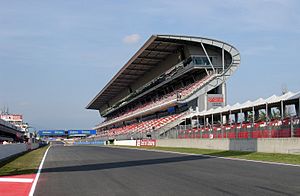
Many running races take place in Barcelona, including the Barcelona Marathon. The Open Seat Godó is a big tennis tournament held every year. Near Barcelona, in Montmeló, the Circuit de Barcelona-Catalunya racetrack hosts Formula One and MotoGP races. Skateboarding and cycling are also very popular, with many bike paths around the city.
Getting Around Barcelona
Airports
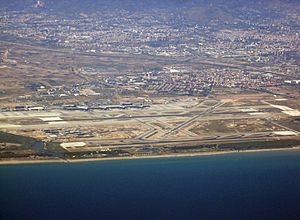
Barcelona is served by Barcelona-El Prat Airport, located about 17 kilometers (11 miles) southwest of the city center. It's the second-largest airport in Spain and handles over 50 million passengers each year. It's a major hub for airlines like Vueling Airlines and Ryanair. The airport connects to the city by metro, train, and bus. A new terminal (T1) opened in 2009.
Some budget airlines also use other airports further away, like Girona-Costa Brava Airport or Reus Airport.
Seaport
The Port of Barcelona has a history stretching back 2,000 years and is very important for trade today. It's one of Europe's largest container ports. The port is currently being expanded to double its size.
Barcelona's harbor is also a leading European port for cruise ships. In 2013, over 3.6 million cruise passengers used the Port of Barcelona.
The Port Vell (old port) area is a popular spot with a shopping mall (Maremagnum), a cinema, and one of Europe's largest aquariums, Aquarium Barcelona.
Trains and Metro

Barcelona is a major hub for Spain's train network. The main station is Barcelona Sants railway station. High-speed trains (AVE) connect Barcelona to Madrid and France.
The city has a large public transport system, including a metro system, buses, and trams. The Barcelona Metro has twelve lines, mostly underground. Several regional train lines also run through the city, connecting it to nearby towns.
Trams and Cable Cars
Barcelona has two modern tram systems, Trambaix and Trambesòs. There's also a historic tram line, the Tramvia Blau, that takes you up to the Tibidabo funicular.
To reach mountain-top spots, Barcelona has funiculars (like a special train on a slope) and cable cars. The Funicular de Montjuïc takes you up Montjuïc hill, and the Montjuïc Cable Car goes to the castle. The Port Vell Aerial Tramway offers amazing views as it crosses over the harbor.
Buses and Taxis
Buses are a major way to get around Barcelona, with many local and night bus routes. The main bus station for long-distance services is the Estació del Nord.
Barcelona has over 10,000 taxis, which are easy to spot with their black and yellow colors. You can find them at taxi stands, wave them down on the street, or call for one.
The city also has a public bicycle service called Bicing. You can pick up a bike from one of many stations around the city and drop it off at another. It's a very popular way to get around.
Roads and Highways
Barcelona is connected by major international roads to places like Madrid, Lisbon, and Paris. The city also has a network of highways and ring roads that help traffic move around and through the metropolitan area.
Main roads in the city include Diagonal Avenue, which cuts across the city, and Gran Via, which goes from east to west. The famous La Rambla is now mainly for walking and is a very popular pedestrian street.
Main Sights in Barcelona
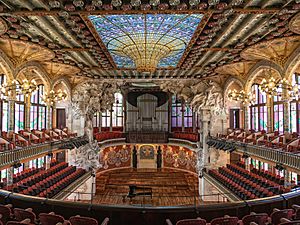
The Barri Gòtic (Gothic Quarter) is the oldest part of Barcelona. Many buildings here are from medieval times, and some even date back to the Roman settlement.
Barcelona is famous for its modernista architecture, a style similar to Art Nouveau. Many of these buildings are World Heritage Sites. The most famous architect is Antoni Gaudí. His most well-known work is the huge, still-unfinished Sagrada Família church, which has been under construction since 1882! It's expected to be finished around 2026.
Barcelona also won the Royal Gold Medal for its architecture in 1999, the first time a city, not just an architect, received this award.
Famous Buildings and Monuments
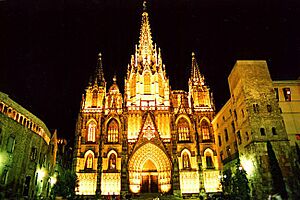

Here are some of Barcelona's most famous buildings and monuments:
- The Sagrada Família church, a symbol of Barcelona.
- Palau de la Música Catalana and Hospital de Sant Pau, designed by Lluís Domènech i Montaner.
- Works by Antoni Gaudí, including Park Güell, Palau Güell, Casa Milà (La Pedrera), Casa Vicens, Casa Batlló, and parts of the Sagrada Família. These are all UNESCO World Heritage Sites.
- The Barcelona Cathedral (Gothic style).
- The Gothic basilica of Santa Maria del Mar.
- The Columbus Monument.
- The Arc de Triomf, a triumphal arch built for an exposition in 1888.
- The Expiatory church of the Sacred Heart of Jesus on Tibidabo mountain.
Museums to Explore

Barcelona has many museums covering different topics and time periods:
- The National Museum of Art of Catalonia has a famous collection of Romanesque art.
- The Barcelona Museum of Contemporary Art shows art from Catalonia and Spain after 1945.
- The Fundació Joan Miró, Picasso Museum, and Fundació Antoni Tàpies have important collections of these famous artists' works.
- For history, there's the Barcelona City History Museum (MUHBA), the Museum of the History of Catalonia, and the Maritime Museum of Barcelona.
- CosmoCaixa is a science museum that won the European Museum of the Year Award in 2006.
- The FC Barcelona Museum is one of the most popular tourist attractions in Catalonia.
Parks and Green Spaces
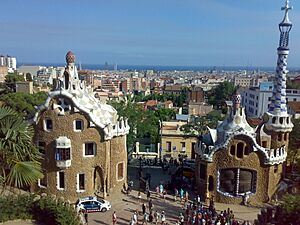

Barcelona has sixty city parks, including historic ones, themed gardens, and urban parks. These green spaces cover about 10% of the city.
Some of the largest parks include:
- Montjuïc: The biggest park, located on the mountain of the same name.
- Parc de la Ciutadella: This park is on the site of an old military fortress and has the Barcelona Zoo and several museums.
- Park Güell: Designed by Antoni Gaudí, this park is famous for its colorful mosaics and unique buildings.
- Diagonal Mar Park: A modern park opened in 2002.
- Tibidabo Amusement Park: A smaller amusement park located on Tibidabo mountain.
Barcelona's Beaches
Barcelona's beaches have been ranked among the top city beaches in the world. The city has seven beaches, stretching for about 4.5 kilometers (2.8 miles) along the coast.
Sant Sebastià, Barceloneta, and Somorrostro are the largest and oldest beaches. Other beaches like Nova Icària and Bogatell were created when the city was updated for the 1992 Olympics. The sand on the beaches is often refilled because storms can wash it away.
International Connections
Barcelona is connected to many cities around the world through "twin city" or "sister city" agreements. These partnerships help cities share ideas and culture.
Twin Cities and Partnerships
Barcelona is twinned with cities like:
- Antwerp, Belgium
- Athens, Greece
- Boston, United States
- Cologne, Germany
- Dublin, Ireland
- Havana, Cuba
- Istanbul, Turkey
- Kobe, Japan
- Monterrey, Mexico
- Montevideo, Uruguay
- Montpellier, France
- Rio de Janeiro, Brazil
- San Francisco, United States
- São Paulo, Brazil
- Shanghai, China
- Tunis, Tunisia
- Valparaíso, Chile
Barcelona also cooperates with other cities, including New York City, United States, and Paris, France.
Images for kids
See also
 In Spanish: Barcelona para niños
In Spanish: Barcelona para niños


